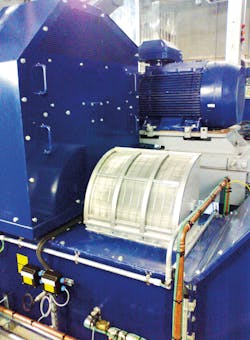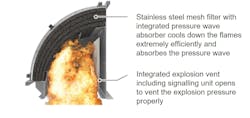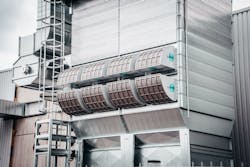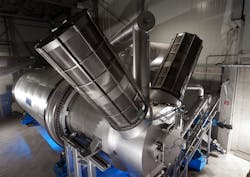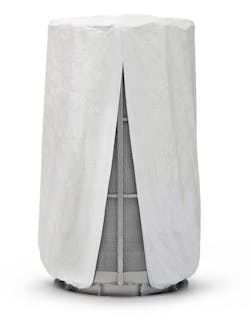Using flameless venting to tame combustible dust explosions
The effects of a dust explosion can be devastating for people, property and processes. When combustible particulate material is handled or produced, the associated fire and explosion hazards must be addressed to prevent catastrophic or fatal consequences. Dust leaks from processing equipment, fugitive dust migration and accumulating dust layers must be managed with equipment design, maintenance and housekeeping to prevent flash fires or explosions. Dust capture and collection systems assist with managing dust escape where dust is produced in material handling and processing equipment. Unlike the building spaces and process areas where dust accumulations are not normally expected, dust collectors and enclosed processing equipment are designed and typically expected to contain bulk material in powder form.
Process dust can occur inherently as a fractional quantity of the material stream or due to attrition or physical processing operations such as crushing, milling, sifting and drying. Where possible ignition sources under normal and rare circumstances cannot be confidently avoided inside process equipment containing combustible dust, the equipment must be protected against the effects of a dust explosion. Without protection, the rapidly generated combustion gases from a contained dust cloud deflagration can exceed the strength of the equipment resulting in rupture, catastrophic failure, projectiles and expulsion of pressure and fireball. This can lead to extreme consequences, including extensive damage, injury, fatality and significant process interruption.
Conventional deflagration venting
Among the various methods to protect against a dust explosion, deflagration relief venting is the simplest and most common. Deflagration venting is a passive explosion protection method consisting of a designed weak point in the protected enclosure, typically a door or panel that quickly opens at a predefined pressure well below the enclosure’s strength limit. This relief vent allows the internal pressure and growing dust-fueled deflagration to exit the vessel before the pressure exceeds the enclosure’s failure strength.
Deflagration relief vents are sized and selected based on established calculations according to standards such as National Fire Protection Association (NFPA) 68 — Standard on Explosion Protection by Deflagration Venting. Deflagration venting is a reliable method of explosion protection for exterior vessels located in unoccupied areas to allow the pressure and fireball to safely discharge.
Extreme care and caution must be considered with respect to the location and orientation of deflagration vents. A vented fireball can extend dozens of feet from the opening with impinging pressures capable of structural damage to adjacent objects. An open deflagration inside a facility not only poses a serious risk associated with fire and pressure discharge but also the potential of a secondary explosion in the building itself. Even a small fraction of an inch of accumulated dust on horizontal surfaces such as beams, pipes, ducts, cable trays, etc. can be enough fuel to destroy a facility from a secondary explosion.
Flameless venting
Flameless deflagration venting (invented by Rembe in the 1980s) addresses this problem, allowing safe, passive explosion venting for vessels located inside facilities or in outside areas where conventional venting is not safe. Flameless venting is a two-part explosion venting system comprised of a rupture panel and a flame arrestor. The rupture panel is a conventional deflagration vent panel that opens at a predefined burst pressure induced by deflagration combustion gas development. The flame arrestor is a matrix of stainless-steel mesh that allows the vented fireball and gases to pass through to the exterior but not before removing the flame.
This flame quenching is accomplished through thermodynamic heat transfer from the burning fireball to the layered network of stainless-steel mesh. The high surface area, thermal conductivity and circuitous path of the mesh rapidly absorbs the fireball heat energy below the flash point, quenching the flame and allowing only gases to exhaust. The mesh also serves as a retention barrier for unburnt dust expelled from the vented vessel, which would otherwise continue to fuel a propagating fireball.
Flameless vents can effectively manage the external hazards from conventional explosion venting. It is important to note that a complete explosion protection strategy must also include isolation to prevent an explosion from propagating to other interconnected equipment and areas.
Sizing and specification
The quenching mesh of a flameless vent imposes some restriction to venting the deflagration compared to conventional open venting for the same geometry. This efficiency factor must be accounted for when calculating the appropriate relief vent area required for each application. The degree of restriction imposed by the flame arrestor is determined experimentally as part of the mandatory testing and certification process.
Flameless vents must be tested and certified by a credible, third-party organization for suitability and reliability under various parameters, including the combustible dust material, test vessel size, pressures and effective vent area compensating for the restriction imposed by the mesh. For example, the temperature of a wood dust deflagration flame front is significantly lower than that of an aluminum dust deflagration. A high-temperature aluminum deflagration could overwhelm the capacity of a flame arrestor designed for lower-grade or organic fuels, resulting in flame discharge or catastrophic failure of the protection device.
The European standard EN 16009 is the generally accepted ATEX directive test standard in Europe for flameless venting devices and satisfies the certification requirement of NFPA 68 for flame arresting and particulate retention venting devices in North America. This standard outlines the process and acceptance criteria of testing flameless explosion venting devices for mechanical integrity, mitigation of flame transmission and venting efficiency. The tests carried out also consider fuel-based performance factors that could cause blockage of the flame arresting media, such as melting or fibrous dusts. Approved use of flameless venting devices with these material types as well as metal dusts must be specifically identified in the testing certification and equipment labeling.
Flameless vents are available in different design geometries with varying performance parameters, efficiencies and costs. Some flameless vents are applicable to all types of equipment, while others may be limited to specific equipment types, such as bucket elevators for example.
Flameless vent application
Application of flameless vents must still consider the surrounding area but with much fewer limitations than with open venting. To achieve successful deflagration venting, the combustion gases must be able to efficiently exhaust to the exterior. The flame arresting mesh must not be located close to a wall, ceiling or structure that could limit the rapid gas relief. Typically, a standoff of around 2 feet is adequate to allow effective gas discharge, but specific application requirements may differ by manufacturer.
Flameless venting effectively manages the hazardous discharge of vented flame and pressure but, depending on the fuel and the vent design and efficiency, the exhaust gases discharging from a flameless vent can still expose personnel to a short-term burn hazard (for example, up to 212 °F [100 °C] for less than 1 second). As a precaution, maintaining a safe zone around flameless vents restricting normal occupancy is recommended. This is not necessarily intended as a complete exclusion zone but rather a limited-duration occupancy area, considering the simultaneous probability and effects of an explosion.
While managing housekeeping and dust accumulations is important for all areas to prevent devastating secondary explosions, the areas around flameless vents must absolutely be kept free from dust accumulations, which could be agitated and suspended from the rapid pressure exhaust.
Flameless venting is extremely advantageous in the manufacturing industry, especially in processes involving significant handling and manipulation of fine, dry combustible material. Typical equipment with explosion hazards often located inside plants include covered conveyers, dryer systems, hammermills, storage bins, silos, sifters, cyclones and baghouses. Even equipment located outside can benefit from flameless venting to manage otherwise challenging explosion vent discharge blast zones.
Flameless vents are easy to install and can be applied to new equipment or retrofit on site. The mass of the device must be factored into the installation design. While some flameless vents can be installed self-supporting from the connection flange, other flameless vents may require supports to distribute and balance the weight loading on the protected equipment.
Flameless venting offers a safe, reliable explosion protection solution with virtually no maintenance. A visual inspection at least once annually is recommended to ensure that there are no deteriorating conditions such as gasket leaks, corrosion or buildup on the exterior mesh, which could impede the unit’s venting efficiency or structural reliability.
Where installed outside, prevention of ice and snow buildup on the mesh is crucial to maintain function and venting efficiency. Specially designed covers can be used to prevent the accumulation of environmental or fugitive process materials on the flame absorbing mesh. Flameless vent covers are designed to fit snugly to the mesh to resist contaminant penetration but release freely from the exhaust gas pressure without imposing additional resistance. Vent covers are tested as part of the device certification to ensure proper calibration and function.
Following a protected explosion, it is critical to minimize process down time, and flameless vents are designed with this in mind. In addition to protecting the integrity of the process equipment, flameless vents can often be reinstalled following a visual inspection, cleaning and rupture panel replacement. A protected process could be back online within hours following an explosion, without the expensive, time-consuming technician startup required by some other explosion protection systems.
Combustible dust explosion hazards can be challenging to manage. The discharge effects of open explosion relief venting require significant amounts of controlled space. Fast-acting chemical explosion suppression systems require frequent maintenance by trained technicians to ensure their reliability, still with a risk of unintentional discharge. When designed and applied appropriately according to the testing and certification parameters, flameless venting can be an efficient and valuable tool to optimize operational space while elevating the safety and reliability of explosion protection solutions.
Jeramy Slaunwhite is chief technical officer, explosion safety, at Rembe, a leading supplier of explosion protection equipment.
Rembe
